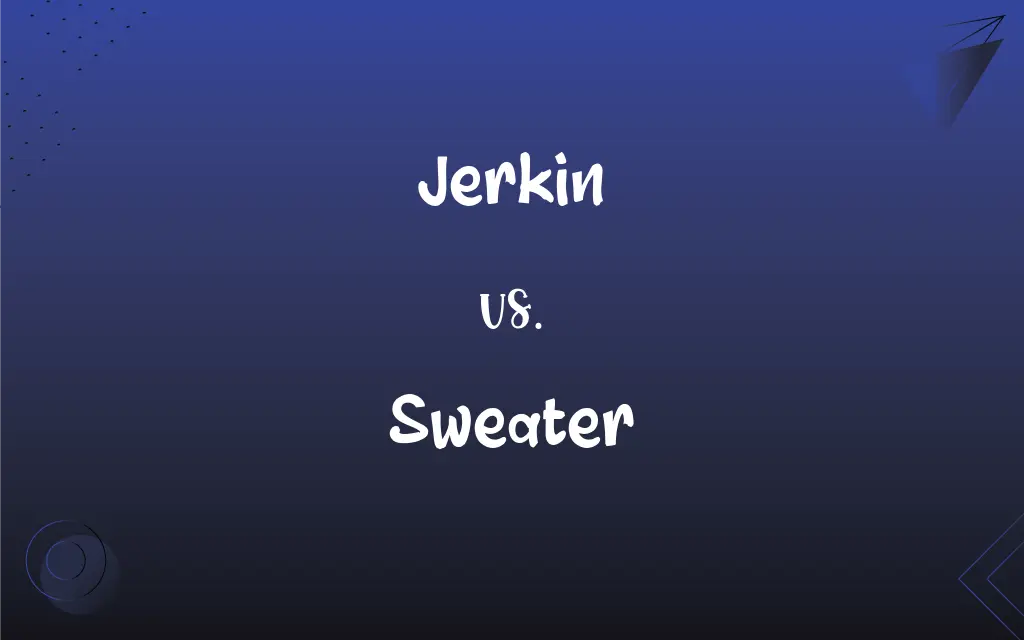Jerkin vs. Sweater: What's the Difference?
By Aimie Carlson || Updated on May 30, 2024
A jerkin is a sleeveless, close-fitting jacket often made of leather, historically worn by men, while a sweater is a knitted garment worn on the upper body, typically with long sleeves, providing warmth.

Key Differences
A jerkin is a sleeveless, close-fitting jacket traditionally made from leather and worn by men in the 16th and 17th centuries. It was often worn over other garments for added warmth and protection. A sweater, on the other hand, is a knitted garment designed for warmth, covering the upper body and usually featuring long sleeves. Sweaters are made from various materials, including wool, cotton, and synthetic fibers.
Jerkins are characterized by their sleeveless design and historical context, often featuring buttons or laces down the front. They are less common in contemporary fashion but can be seen in historical reenactments and period dramas. Sweaters, however, are everyday wear, available in a wide range of styles, including pullovers and cardigans, making them versatile and fashionable.
The material used for jerkins is usually thicker and more durable, such as leather, making them suitable for outdoor or work-related activities. Sweaters are typically softer and more flexible, prioritizing comfort and warmth, and are suitable for casual and formal settings.
Jerkins do not provide arm coverage, thus are often worn with other layers underneath. Sweaters provide complete upper body coverage, including the arms, and can be worn on their own or layered with other clothing for additional warmth.
Comparison Chart
Sleeves
Sleeveless
Long sleeves
ADVERTISEMENT
Material
Typically leather
Various materials (wool, cotton, synthetic)
Historical Context
Worn in the 16th and 17th centuries
Modern clothing item
Usage
Historical reenactments, utilitarian purposes
Everyday wear, warmth and comfort
Design
Close-fitting, buttons or laces down front
Knitted, various styles (pullover, cardigan)
Jerkin and Sweater Definitions
Jerkin
A sleeveless jacket worn over other garments.
The medieval soldier wore a leather jerkin for protection.
ADVERTISEMENT
Sweater
A knitted garment worn on the upper body for warmth.
She wore a cozy sweater on the chilly autumn day.
Jerkin
A close-fitting, often leather garment from the 16th century.
The actor donned a jerkin for his role in the historical play.
Sweater
A knitted top worn casually or formally.
Her favorite outfit included a soft, pink sweater.
Jerkin
An item of clothing associated with historical attire.
The museum's exhibit featured a 17th-century jerkin.
Sweater
A versatile garment available in various styles.
The store had a sale on sweaters, both pullovers and cardigans.
Jerkin
A sleeveless piece of outerwear, usually fastened in the front.
The craftsman wore a jerkin while working with tools.
Sweater
A piece of clothing with long sleeves, made from wool or other materials.
He received a woolen sweater as a Christmas gift.
Jerkin
A traditional vest-like outerwear for men.
During the Renaissance fair, participants dressed in jerkins.
Sweater
A garment for the upper body of wool, cotton, or synthetic yarn, typically knitted, having long sleeves, and worn in cold weather.
Jerkin
A close-fitting, hip-length, collarless jacket having no sleeves but often extended shoulders, belted and worn over a doublet by men especially in the 1500s.
Sweater
One that sweats, especially profusely.
Jerkin
A short, close-fitting, often sleeveless coat or jacket, usually of leather.
Sweater
Something that induces sweating; a sudorific.
Jerkin
(historical) A type of men's garment popular in the sixteenth and seventeenth centuries: a close-fitting collarless jacket, with or without sleeves.
Sweater
A knitted jacket or jersey, usually of thick wool, worn by athletes before or after exercise.
Jerkin
A sleeveless jacket, usually leather; a long waistcoat.
Sweater
(US) A similar garment worn for warmth.
Jerkin
A jacket or short coat; a close waistcoat.
Sweater
One who sweats (produces sweat).
Jerkin
A male gyrfalcon.
Sweater
One who or that which causes to sweat.
Jerkin
A tight sleeveless and collarless jacket (often made of leather) worn by men in former times
Sweater
A diaphoretic remedy.
Sweater
(historical) An exploitative middleman who subcontracted piece work in the tailoring trade.
Sweater
(archaic) One who sweats coins, i.e. removes small portions by shaking them.
Sweater
A London street ruffian in Queen Anne's time who prodded weak passengers with his sword-point.
Sweater
(transitive) To dress in a sweater.
Sweater
One who sweats.
Sweater
One who, or that which, causes to sweat
Sweater
A crocheted or knitted garment covering the upper part of the body
Sweater
A person who perspires
Sweater
A clothing item worn in cold weather to provide insulation.
The children put on their sweaters before going outside to play.
FAQs
What is a sweater?
A sweater is a knitted garment with long sleeves worn on the upper body to provide warmth.
What is a jerkin?
A jerkin is a sleeveless, close-fitting jacket, historically made of leather, worn by men in the 16th and 17th centuries.
Do jerkins provide warmth?
Jerkins provide some warmth, mainly to the torso, and are often layered over other clothing.
Are jerkins still worn today?
Jerkins are rarely worn in contemporary fashion but may be used in historical reenactments and period costumes.
What materials are sweaters made from?
Sweaters can be made from wool, cotton, synthetic fibers, and blends of these materials.
Can sweaters be worn for formal occasions?
Yes, certain styles of sweaters can be worn for formal occasions, especially when paired with appropriate attire.
Are sweaters versatile in fashion?
Yes, sweaters are very versatile and come in various styles suitable for different occasions and outfits.
What are some common styles of sweaters?
Common styles of sweaters include pullovers, cardigans, turtlenecks, and crewnecks.
Are sweaters typically casual or formal wear?
Sweaters can be both casual and formal, depending on the style and how they are accessorized.
Can sweaters be machine-washed?
Many sweaters can be machine-washed, but care instructions should be followed to avoid damage.
What is the primary purpose of a jerkin?
Historically, the primary purpose of a jerkin was to offer protection and warmth while allowing freedom of movement.
How are jerkins typically fastened?
Jerkins are usually fastened with buttons or laces down the front.
Did women wear jerkins historically?
Historically, jerkins were primarily worn by men, but there are instances of women wearing similar garments.
Can sweaters be worn year-round?
Sweaters are typically worn in cooler weather, but lighter versions can be worn year-round.
Do jerkins have sleeves?
No, jerkins are sleeveless garments.
Were jerkins worn for protection in battle?
Yes, jerkins were sometimes worn for added protection in battle, especially over armor.
Is a jerkin considered a vest?
Yes, a jerkin can be considered a type of vest, particularly due to its sleeveless design.
What is the difference in historical significance between a jerkin and a sweater?
Jerkins have historical significance tied to the 16th and 17th centuries, while sweaters are more modern and do not carry the same historical context.
Are sweaters knitted or woven?
Sweaters are generally knitted.
What is the main functional difference between a jerkin and a sweater?
The main functional difference is that jerkins are sleeveless and often worn for historical or protective purposes, while sweaters provide full coverage and are worn primarily for warmth.
About Author
Written by
Aimie CarlsonAimie Carlson, holding a master's degree in English literature, is a fervent English language enthusiast. She lends her writing talents to Difference Wiki, a prominent website that specializes in comparisons, offering readers insightful analyses that both captivate and inform.































































